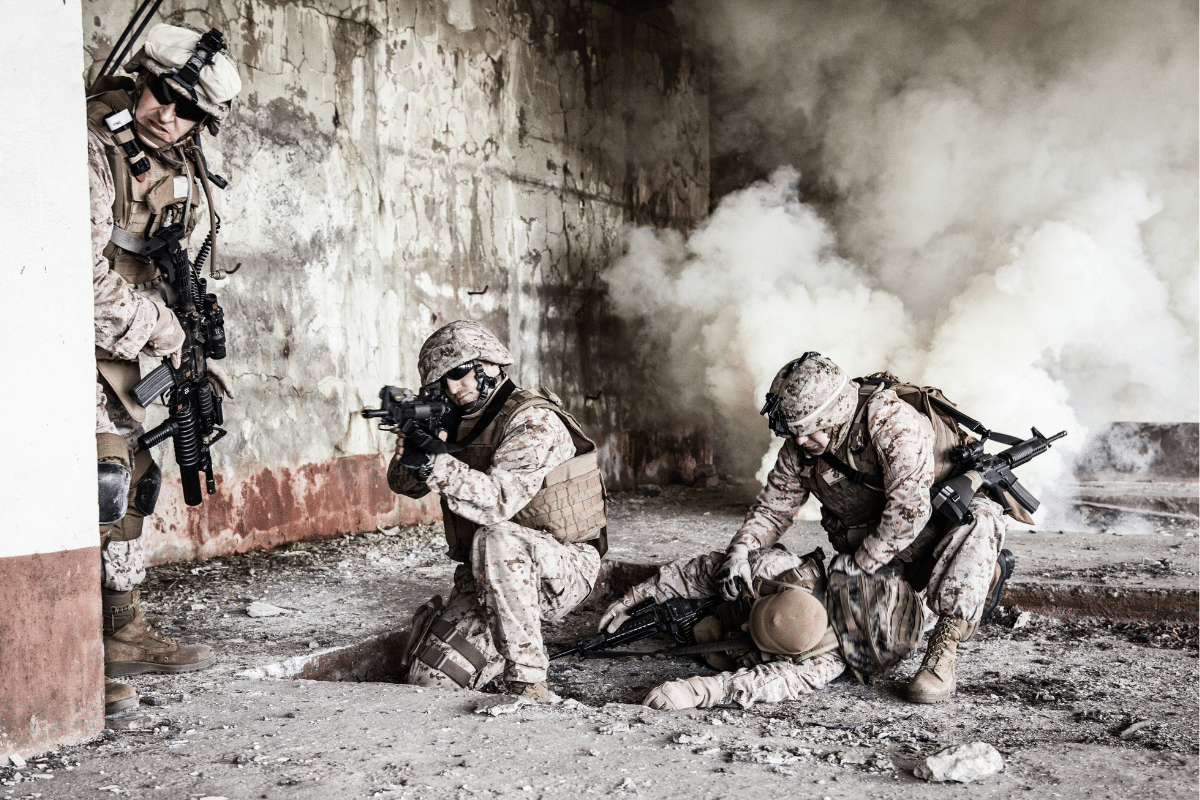
Shrapnel wounds can inflict devastating injuries on veterans, leaving them with lasting physical and psychological consequences. Understanding the VA Rating for shrapnel wounds helps veterans and their families receive fair compensation for the lifelong effects of this disability.
This article will delve into the different aspects of shrapnel wounds and their impact on veterans. We will explore the categorization of muscle disabilities resulting from shrapnel wounds, including their ratings and the criteria used by the VA. Additionally, we will discuss the adverse health effects caused by shrapnel, the connection between shrapnel and traumatic brain injuries (TBIs), and the VA disability rating for scars while providing insights into proving service connection for scars and the necessary steps to file a claim.
Before this article concludes, you will have a comprehensive understanding of the complexities surrounding shrapnel injuries and the available resources for veterans seeking compensation and support. Remember, while we can provide valuable information, consult a Va accredited law group like VetsForever or a Veteran Service Officer (VSO) for personalized assistance to navigate the VA claims process.
1. What Are Shrapnel Wounds?
A shrapnel wound is a traumatic injury observed in veterans occurring when an explosive device propels metal fragments and debris into the air. Gunshot or shell fragments are the most common sources of these high-velocity projectiles that can cause harm to the skin and muscles, necessitating debridement by an emergency medical provider. In modern warfare, military forces sometimes employ bombs or bullets incorporating additional pieces of metal or corrosive materials.
These fragments penetrate soft tissue and can inflict harm on organs or bones, potentially resulting in fatality depending on the severity and location of the injury. However, when a fragment becomes embedded, it can exacerbate the damage by either the material it is composed of or its movement within the body.
2. Categories of Muscle Disabilities from Shrapnel Wounds
The VA categorizes shrapnel wounds as muscle disabilities into four categories: slight, moderate, moderately severe, and severe. When assessing muscle disabilities, the VA refers to diagnostic codes 5301 through 5323. The following classifications are used to rate muscle injuries:
- Slight muscle disabilities resulting from shrapnel typically involve superficial wounds without infection or debris. These wounds heal well, have no signs or symptoms, and veterans with such disabilities maintain mobility.
- Moderate muscle disabilities caused by shrapnel are more profound and penetrating than slight disabilities, but like them, they are not infected and do not contain debris. Veterans with moderate disabilities may experience scarring, muscle tone loss, related symptoms, and other health issues resulting from the shrapnel.
- Moderately severe disabilities from shrapnel often involve deep, penetrating wounds with long-term infections that may still contain debris and the development of limiting scar tissue. Scar tissue in the affected muscles can lead to problems with strength, endurance, and mobility. Veterans with this type of disability often require hospitalization and continue to experience symptoms.
- Severe muscle disabilities caused by shrapnel are typically severe, accompanied by long-term infections, significant scarring, limited range of motion, and chronic conditions such as pain and arthritis. Many veterans with severe disabilities cannot work and face challenges in performing everyday tasks like walking and bathing.
3. Negative Health Effects Caused by Shrapnel
The term the VA uses to describe shrapnel is “toxic embedded fragments.” Shrapnel refers explicitly to the metallic fragments originating from bullets, bombs, and other debris expelled during combat-related explosions.00
According to the VA, the health effects of toxic embedded fragments are not entirely comprehended, but typically, these fragments pose potential harm in two manners:
- Damage occurs at the location where the fragment is embedded.
- Chemicals originating from the fragment can circulate in the bloodstream and impact various areas of the body.
4. Understanding the VA Rating for Shrapnel Wounds
A clear understanding of how the VA Rating for shrapnel wounds is obtained is essential when discussing the health consequences of toxic shrapnel fragments. Referred to as “Shrapnel Sickness,” these fragments have been linked to heightened levels of toxic materials like lead, copper, and cadmium in the urine of over 8,000 enlisted Gulf War veterans. The gradual deterioration of these metals within the body can lead to various complications, encompassing cardiac, liver, reproductive, blood, nervous system, kidney, and gastrointestinal disorders. Notably, cadmium, arsenic, chromium, and lead, present in shrapnel fragments, are recognized as carcinogenic substances.
Based on a 2016 report featured in Public Health Reports, it was found that numerous types of shrapnel contain uranium. Exposure to uranium can result in various health problems, such as kidney damage, liver cancer, and bone cancer. It can also induce high blood pressure, autoimmune disorders, and reproductive function impairment.
5. Shrapnel and Traumatic Brain Injury
Shrapnel injuries have the potential to cause TBIs. A shrapnel fragment entering the skull can directly harm the brain tissues, resulting in immediate trauma. You may encounter various symptoms if you have experienced TBI due to a shrapnel injury, including:
- Mental Disorders
- Speech Impairment
- Loss of Muscle Control
- Drastic Personality Changes
- Coma
The rating for traumatic brain injuries caused by shrapnel wounds depends on your specific symptoms. For example, if you develop a brain abscess due to the injury, you will receive a 100% rating while the condition is active and for three months afterward. Subsequently, a new rating will be determined based on the condition of your central nervous system, with a minimum rating of 10 percent.
5. VA Disability Rating for Scars
In general, the VA assesses and rates scars depending on various factors, that includes the quantity of scars, their location, permanence, and the level of pain experienced by the veteran. The VA will assign ratings of 10%, 20%, 30%, 40%, 50%, or 80% to your scars based on the following criteria.
Scars on your head, neck, and face are rated much higher than lower on your body. Scars are rated according to the official diagnostic code 38 CFR §4.118, specifically codes 7800, 7801, 7802, 7804, and 7805. The VA determines compensation ratings for scars in these categories:
- 7800: Scars to the Head, Face, and Neck – Ratings range from 10% to 80% based on specific characteristics and the VA’s assessment.
- 7801: Scars Below the Head, Face, and Neck that are Deep and Nonlinear – Ratings are determined based on the scar size, with percentages ranging from 10% to 40%.
- 7802: Superficial and Nonlinear Scars – Superficial scars affect the topmost skin layer and are not permanent. Each scar receives a separate rating, with a standard rating of 10% for scars that cover an area of 144 square inches or greater.
- 7804: Painful or Unstable Scars – Painful or unstable scars that frequently lose skin covering can receive a rating of 10% or higher, depending on the number of scars present.
- 7805: Other Scars and Effects Not Covered by Previous Codes – Scars falling under this category are evaluated based on their debilitating effects. For example, keloid scars have a standardized rating of 30%.
The VA determines individual ratings based on the specific characteristics of the scars. Surgical scars are generally considered superficial and receive a standard 10% rating unless your surgical scar is both unstable and painful, which would be rated at 20%.
7. How to Prove Service Connection for Scars
To obtain a VA disability rating for scars, you must establish a service connection by demonstrating that the scars resulted from or were aggravated by an event, injury, or illness during your military service. The specific evidence needed will vary based on the origin of your scars, such as whether they were acquired in combat, through an accident, or medical procedure.
When it comes to filing for your VA rating for scars, there are a few important steps you should follow:
- Gather your evidence and submit your intent to file.
- Submit your claim online, in person, or by mail using VA Form 21-526EZ.
- Await a decision, which may include a scheduled examination by the VA.
- If necessary, you can appeal the decision or request a rating increase.
- Along with your VA claim, you must submit the Scars Disability Benefits Questionnaire (DBQ) form.
A doctor completes the DBQ, typically the C&P (Compensation and Pension) examiner, and aids the VA in assessing your claim. Reviewing the form before your C&P exam is advisable to understand the examiner’s questions. Additionally, keeping a record of all medical treatments related to the scars and any changes or worsening of the scars following your military service is crucial. This documentation can further support your case for a VA disability rating.
Summary
In conclusion, shrapnel wounds can have profound and lasting effects on veterans, both physically and psychologically. Understanding the VA Rating for shrapnel wounds is crucial to ensure that veterans and their families receive the necessary support and compensation to cope with the lifelong impact of these injuries.
By following the necessary steps to prove service connection and submitting the required documentation, veterans can navigate the VA claims process effectively. Remember, seeking the guidance of a Veteran Service Officer (VSO) can provide valuable assistance throughout their journey. Together, we can ensure that veterans receive the recognition and support they deserve for their sacrifices in service to our nation.
FAQs
What is a shrapnel wound?
A shrapnel wound is an injury caused by explosive devices, such as artillery shells or bombs, which propel metal fragments and debris into the air. These high-velocity projectiles can penetrate the skin, muscles, organs, or bones, potentially leading to severe harm or fatality.
How does the VA evaluate shrapnel wounds for disability compensation?
The VA assesses the severity of the shrapnel wounds, including the location, depth, and impact on bodily functions. It also considers any associated complications, such as infections or chronic pain. The VA may request medical examinations and review medical records to gather evidence for the evaluation. Based on the findings, the VA assigns a disability rating, ranging from 0% to 100%, which determines the level of compensation the veteran is eligible to receive for their shrapnel wounds.
Can veterans with shrapnel wounds receive other benefits besides disability compensation?
Yes. These benefits include healthcare services, vocational rehabilitation, education and training, home loan assistance, dependents and survivors benefits, and adaptive housing grants. Veterans need to explore these options and consult with a Veterans Service Officer or the VA directly for eligibility and application processes.
Can I appeal a denied VA disability claim for shrapnel wounds?
Yes. In February 2019, the VA introduced a more efficient appeals process with three options:
- Higher-Level Review Lane: A senior claims adjudicator thoroughly reviews the existing record. No new evidence can be introduced at this stage.
- Supplemental Claim Lane: Appellants can add “new and relevant” evidence to their existing case file, providing additional support for their claim.
- Board of Veterans’ Appeals Lane: Appellants can directly appeal cases directly to the Board of Veterans’ Appeals, which offers three dockets:
-
- Evidence Submission Docket: Present new evidence to the Board without requesting a hearing.
- Hearing Docket: Request a hearing, present new evidence, and have the opportunity to present the case in person.
- Direct Review Docket: Request a review only after submitting new evidence or requesting a hearing.
-
Can veterans with shrapnel wounds receive VA disability compensation for secondary conditions?
Yes. The VA recognizes that shrapnel wounds can have long-lasting effects on a veteran’s overall health and may lead to additional medical conditions. If it can be established that the secondary condition is directly related to the shrapnel wound or its treatment, veterans can seek compensation for these secondary conditions.

